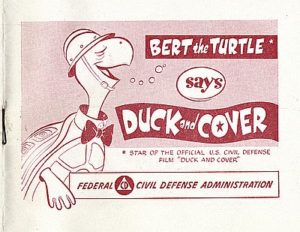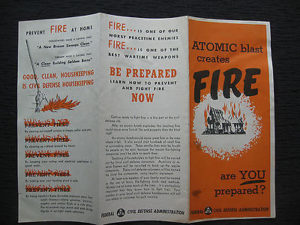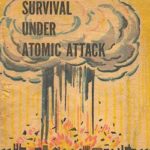My formative years occurred during the tail end of the Cold War, so in addition to earthquake drills (since we lived on a fault line), we also had frequent “nuclear” drills. These drills consisted of exercises like “Duck and Cover” (we climbed under our desks and covered our heads), or “Basement Shelter Drills” (we formed an orderly line and marched to the community bomb shelter in the basement of the school).
Our teachers handed out pamphlets like “Duck and Cover” (I loved that we could color in Bert the Turtle on the cover) or “Fire and Blast” (which showed us how not to burn alive [as quickly] in the event of a nuclear war).

I loved that we could color the turtle!

Not very fun reading.
But, my personal favorite was the pamphlet published by the Office of Civil Defense entitled, “Survival Under Atomic Attack“. I liked the title because it implied hope in what seemed like a hopeless situation.
Back in those days, teachers didn’t have to warn kids about “potential triggers” while teaching sex-ed classes – they knew that there was a difference between being triggered and being uncomfortable. Nor did they have to worry about books being banned (like Dr. Seuss’ Green Eggs & Ham because it “may promote marxism“).
These days, kids aren’t getting valuable information about how to survive a bomb. I thought I would share this important information so that, you too, can survive a nuclear attack. Here are some important tips (and a few of my favorite passages) from the pamphlet, “Survival Under Atomic Attack”.
The Cover
Let’s face it: this is a no-nonsense cover. Back when I was growing up, we never sugar-coated death. The cover is bright orange and features a giant mushroom cloud, random explosions over the city, buildings on fire and a general sense of doom. I’m actually a little surprised they didn’t have little stick figures being evaporated in the sky (but no worries, we drew them in on the covers of our personal copies).
Fortunately, we were all trained well in what to do in a nuclear disaster. This booklet details all things you need to survive. Let’s take a look at a few of my favorite highlights.
– It’s Optimistic: No matter how bad war gets, there is a bright side, according to the Department of Civil Defense (which is essentially the Harry Potter equivalent of the Ministry of Magic). Here’s an actual quote from the book:
Because the power of all bombs is limited, your chances of living through an atomic attack are much better than you may have thought. In the city of Hiroshima, slightly over half the people who were a mile from the atomic explosion are still alive.
– Total Power is Limited: Originally, I thought nuclear bombs were the worst. But then our pamphlet taught us about hydrogen bombs (fortunately, they’re not as bad as I originally thought):
While an atom bomb holds more death and destruction than man has ever before wrapped in a single package, its total power is definitely limited. Not even hydrogen bombs could blow the earth apart or kill us all by mysterious radiation.
Your Chances of Survival
Forutnately, the war department is happy to discuss your chances of survival in this workbook! Here’s how they explain your odds:
If a modern A-bomb exploded without warning in the air over your home town tonight, your calculated chances of living through the raid would run something like this:
Should you happen to be one of the unlucky people right under the bomb, there is practically no hope of living through it.
In fact, anywhere within one-half mile of the center of explosion, your chances of escaping are about 1 out of 10.
On the other hand, and this is the important point, from one-half to 1 mile away, you have a 50-50 chance.
From I to I 1/2 miles out, the odds that you will be killed are only 15 in 100.
And at points from 1/2 to 2 miles away, deaths drop all the way down to only 2 or 3 out of each 100. Beyond 2 miles, the explosion will cause practically no deaths at all.
Naturally, your chances of being injured are far greater than your chances of being killed.
Our teacher found this to be an opportune time to open the topic up to discussion, usually in a twisted form of “would you rather” style of questioning at a round table.
- Would you rather be in the initial blast zone with your family, or 5 miles away at school without your family?
- Would you rather be in a bomb shelter 1 mile away from the blast site with your dog, or in another country without your dog?
A bit macabe? Sure. But, it’s all in the name of higher education. In my day, nuclear bombs were opportunities for learning. For example, if we happened to be caught in math class during a nuclear drill (the most dreaded of all scenarios), it was inevitable that we would be answering word problems while hunkering down in the school’s fallout shelter.
- Jack can run 15 mph. Ethel can run 12 mph [because in my day, women were always considered weaker and couldn’t run as fast]. If Jack and Ethel are 1/2 mile from the central blast zone, how fast will they be able to reach a safety zone?
- If you are 1 mile from the blast zone and your vehicle is traveling at 45 mph away, how fast would you have to drive to increase your odds of survival to 1 in 10?
My primary goal eventually shifted from survival to not being anywhere within five miles of math class during a nuclear blast…
What about Super Bombs?
Even in the 70s, we had #FakeNews and wasteful government spending. Case in point:
Do not be misled by loose talk of imaginary weapons a hundred or a thousand times as powerful. All cause destruction by exactly the same means, yet one 20,000-ton bomb would not create nearly as ‘much damage as 10,000 two-ton bombs dropped a little distance apart. This is because the larger bombs “waste” too much power near the center of the explosion.
Abandon All Hope, Ye Who Enter
The pamphlet doesn’t want to leave you without hope. I mean, it’s operating on the following premise:
Just like fire bombs and ordinary high explosives, atomic weapons cause most of their death and damage by blast and heat. So first let’s look at a few things you can do to escape these two dangers.
So it gives you lots of little tips for survival. The first order of business is to fall on your face.
Even if you have only a second’s warning, there is one important thing you can do to lessen your chances of injury by blast: Fall flat on your face.
The government offers a lot of rational reasons why you should do this, but at this point, even as an eight year old, I was rolling my eyes. This is when I assumed the government had cameras installed at the school and men in suits were sitting at their desks in a basement, their feet propped up on a desk while they ate popcorn, watching footage of everyone in our class practicing “face falls”.
But, What about Radioactivity?
Good news! Radioactivity is apparently way overrated. What you really need to worry about is the heat from the first wave.
Radioactivity is the only way—besides size — in which the effects of A or H bombs are different from ordinary bombs. But, with the exception of underwater or ground explosions, the radioactivity from atomic bursts is much less to be feared than blast and heat.
I’m not sure if that sets your mind at ease or not. Either way, relax – radiation is the least of your problems.
The pamphlet goes on to explain why you don’t really need to fear radiation (because hellfire is much worse). In fact, there are many different types of radiation:
Broadly speaking, atomic explosions produce two different kinds of radioactivity. First—and most important in an air burst—is an extremely powerful invisible burst of rays and particles thrown off at the time of explosion. This kind is called “initial” or explosive radioactivity. Its rays and particles fly out quickly, then promptly die. There is danger from them only for little more than a minute. The second type of lingering radioactivity—will be described later.
The pamphlet goes on to give some important advice:
NEVER LOSE YOUR HEAD
[Yes, that is the actual advice the pamphlet gives to you.]
The pamphlet goes on to discuss many other things (and if you’re nice to me, I’ll share). If not, you can read it yourself in the Boston version of the pamphlet. Apparently, it wasn’t just my elementary school that did regular drills.
The big question at the end of the day, “Surely there are better ways to detract from the pathetic political climate – perhaps one that doesn’t result in all of us dying a terrible death?”
I still have my copy of this pamphlet lying around somewhere, but it’s probably buried in the garage with other long lost books that don’t fit on any of my ten large bookshelves around the house. Fortunately, we now have the internet to use for survival.
I hope you have enjoyed this story and have learned a few ways to survive in the event of a holocaust. If you have, leave a comment and tell me what you studied in school!




